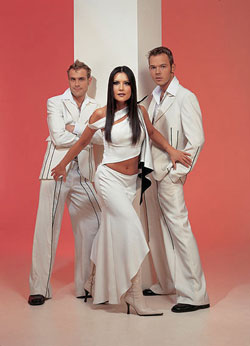Our friends at City Paper, a bimonthly magazine and tourist guide in Tallinn, Estonia, sent us a press release crowing about being one of the few publications to correctly predict that Marija Naumova of Latvia would win last year’s Eurovision Song Contest.
And now Editor Michael Tarm and the rest of the staff have picked this year’s winner: Russia.
Come May 24, I hope they’re wrong.
Not that Russia shouldn’t deserve to win the Eurovision contest some year. But I want to believe that Russia’s entry this year, “Ne ver, ne bojsia, ne prosi” (No Faith, No Belief) sung by the controversial duo t.A.T.u., is not the winner others are saying it is. To my ear, it doesn’t sound like anything new from Elena Katina and Julia Volkova, although the song does stand out from some of the sugary stuff offered by other entrants.
Besides, part of the trick of Eurovision—as Naumova’s victory showed last year—is putting on an impressive stage show that will wow television viewers across Europe. The Russian duo, who have filled the world press with questions about their sexuality and sexual identity, probably will have to up the shock factor to convince audiences that they should earn the Eurovision title.
I can hardly wait.
Russia, City Paper argues, has the most professional of the 26 entries that will be vying for the honors in Rīga’s Skonto Hall. To lose would be an embarassment.
City Paper rounds out its top five choices with Estonia, Norway, Turkey and Iceland. Latvia’s entry, “Hello from Mars” performed by the trio F.L.Y. (composed of Mārtiņš Freimanis, Lauris Reiniks and Yana Kay) places 15th in the publication’s list. And at the bottom is Sweden’s Fame and the song “Give Me Your Love,” which City Paper calls “as hackneyed as they come.”
In announcing its prediction, City Paper acknowledged that the Eurovision contest is about pop music, but it looked for songs that stood out from the pack. That’s one reason, according to the press release, the publication picked Estonia’s entry for the No. 2 spot, while holding out the suggestion that the song could in fact win. Estonia’s entry, “Eighties Coming Back” performed by the group Ruffus, is “the least pretentious, the most gritty of this year’s crop of songs,” City Paper said.
I’ll agree Estonia’s entry is different, but I’d rate it in the middle of the pack. A song about the return of the 1980s? C’mon…
And I’m convinced Latvia won’t win this year. F.L.Y. makes a nice trio, and each of the singers is already an accomplished artist, but “Hello from Mars” just doesn’t shine compared to a few other songs in the competition.
My favorites include Turkey, France and Belgium. Turkey’s Sertab Erener offers “Every Way That I Can,” a song with just a tinge of the East, enough to remind listeners that it’s from a country that bridges two continents. France’s Louisa Baileche performs “Monts et merveilles” (The Moon and the Stars), a restrained love song that stands out in part for not being as pop-oriented as other entries. And Belgium’s Urban Trad draws attention with “Sanomi,” a song more at home in a world music contest than in Eurovision—which probably explains why it’s last in the online ratings on the Web site for the song contest.
Those same ratings put Russia first, just as City Paper does.
Let’s see what the voters say. Maybe City Paper will have to eat crow.

Performing “Hello from Mars,” Latvia’s entry in the Eurovision Song Contest, will be F.L.Y., composed of Mārtiņš Freimanis, Yana Kay and Lauris Reiniks.



